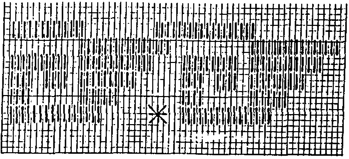Roman Breads
The following recipes are from Ancient Roman Feasts and Recipes Adapted for Modern Cooking by Jon and Julia Solomon, published by E.A. Seeman, Miami, FL. Aethelthryth of Aclea sent this reference. The book contains not only recipes, but pages of information Roman life and cooking as well as dining habits. If you can't get a copy, try interlibrary loan and copy interesting recipes for future use.
Cato's Cheese Bread (Libum)
This bread was often used in religious services.
1 cup feta cheese, drained and crumbled and packed into a measuring cup
(you can also use ½ cup feta and ½ cup cottage cheese for economy)
½ cup unbleached all-purpose flour
1 egg, beaten
6 bay leaves
2 tablespoons honey (optional)
Put the cheese in a mixing bowl or food processor and mash well until it becomes a smooth, lumpless paste. Add the flour and mix well with the fingers. Add beaten egg and mix. The dough will be sticky.
Divide the dough into two equal parts and form two round, flat cakes about ½ “ thick. Lay each on 3 bay leaves set on a greased baking sheet and back in a preheated oven at 400° for 1 to 1 ½ hours or until cooked through.
Remove the loaves from the oven. You may spread them with honey. Remove the bay leaves before serving.
Cato's Grape Bread (Mustaceus)
These were often used at weddings.
4 cups unbleached, all-purpose flour
½ cup lard or shortening
¼ cup feta cheese crumbled and mashed into a paste
1 teaspoon cumin seed, ground
1 teaspoon anise seed, ground
1 ½ cups grape juice, purple or white
1 package dry yeast
8 bay leaves
Place flour, lard, cheese, cumin, anise and yeast in a large bowl and blend well. Add the grape juice and mix well until the juice is absorbed and evenly distributed. Dough will be damp and sticky, but should have no dry areas. If it does, continue mixing until they go away.
Let the dough rest 5 minutes. Sprinkle 1 to 2 tablespoons of flour over the dough and knead on a floured surface for 5 to 10 minutes or until the dough is smooth, elastic and only slightly sticky. Add more flour if needed Let the dough rest 2 minutes.
Kneed dough for 30 seconds more, return to the bowl, cover with a towel and let rise at room temperature for 3 hours.
Sprinkle the top with flour. Punch down and form the dough into four rectangular loaves (4” by 2” by 1 ½ ”) Place 2 bay leaves on the bottom of each loaf and lay them leaf-side down on a greased cookie sheet. Cover with a towel an let rise for one hour.
Bake in a preheated 400° oven for 35 minutes, until the laves are brown on top and make a hollow sound when tapped. Remove by leaves and serve when cooled.
If you want unleavened bread, leave out the yeast, knead the dough thoroughly and bake at 350° for about 2 hours. Romans thought unleavened bread was 'manlier' and better for the digestion.

Back to Early Period #3 |
Back to Early Period Index |
Back to PastTimes

